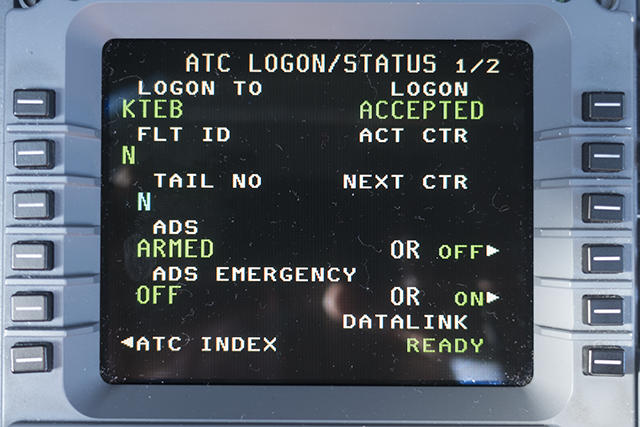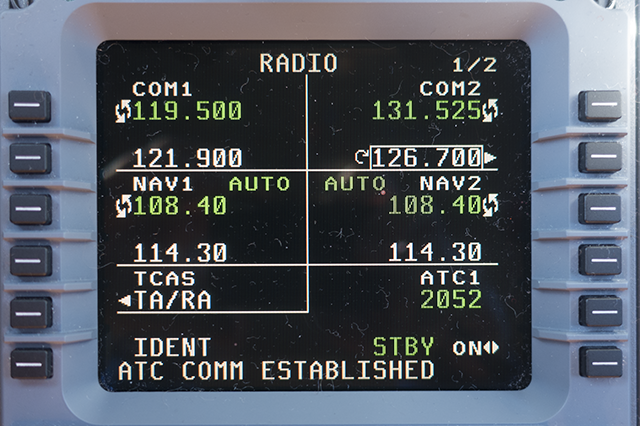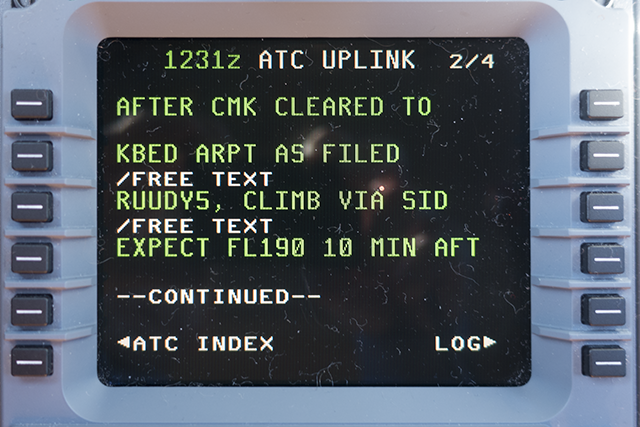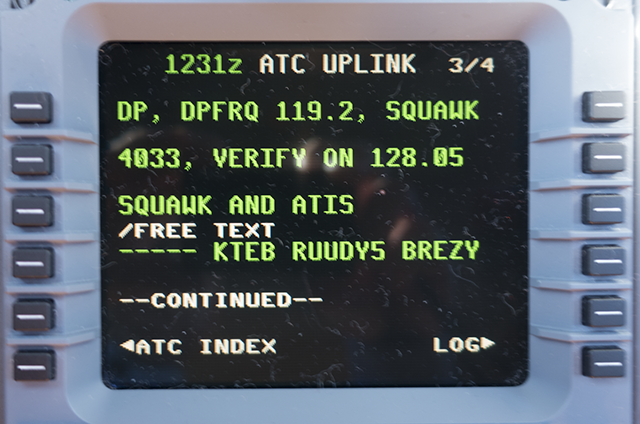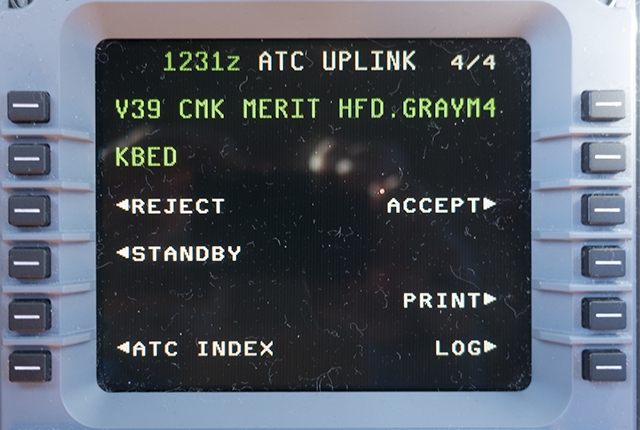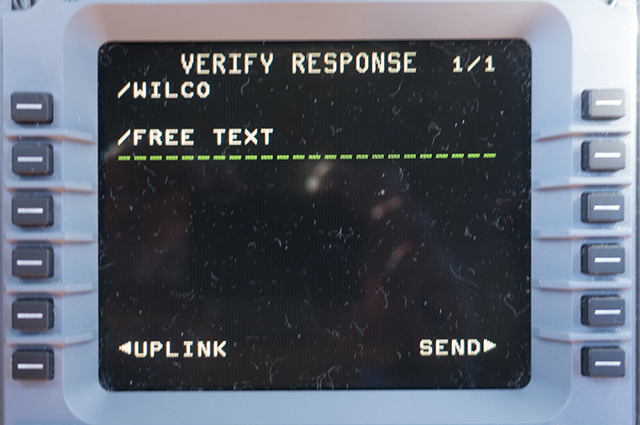If your FMS obtains your Pre-Departure Clearance (PDC) through a function called DCL, you probably are CPDLC equipped and can receive both PDC and DCL clearances. The differences are subtle right now, but will become pretty important in the future.
— James Albright
1
Defined
PDC
PDCs are generated by a controlling agency at designated airports (primarily in the US National Airspace System). Operators must subscribe to this service via an AOC service provider (e.g. Honeywell's Global Data Center). PDCs are sent from the FAA to the service provider to be stored in their system for dissemination. The service provider then sends the clearance to the aircraft (via the ACARS network) or other device, or holds it until the flight crew requests it via the FMS AOC pages. It is important to note the following:
- PDC does not support revisions to the flight plan of any kind – any flight plan that has been revised is not eligible for PDC services.
- A PDC can only be issued once in a 24-hour period for a given call sign at a given airport – even if the initial PDC is not delivered the first time, subsequent submissions will be denied.
- PDC is only supported thru an AOC service provider.
- PDCs are requested thru the AOC FMS or AOC CMF menus (e.g., CMU ATS menu).
Source: Honeywell
DCL (US)
DCL in the US is a departure clearance issued over the FANS 1/A data link system using Controller Pilot Data Link Communication (CPDLC). The aircraft must be certified for FANS 1/A or FANS 1/A+ data link and have DCL capability. The flight crew must request a DCL from the FMS by first logging into the FANS system to establish a CPDLC (ATC COMM) session, and then using the appropriate data link menus to send FANS downlink message directly to ATC. The FAA responds with the clearance on file, after which the crew has the ability to accept, reject, standby, and, on many aircraft, load the clearance directly into the FMS with a single button push.
- DCL communication is directly between ATC and the flight crew – unlike a PDC, a DCL is never routed to the aircraft through an AOC service provider
- Requests for a DCL in the US are initiated in the FMS CPDLC menus (Honeywell equipment)
- DCL enables digital delivery of revisions to clearance – ATC may send revisions to the original clearance up to time of departure
Source: Honeywell
Information about DCL had been spotty at first and sometimes inaccurate. The following comes from a trusted source at Rockwell-Collins as of August 2017:
FANS DCL in the U.S. is not requested via a downlink from an aircraft. If the aircraft is FANS CPDLC capable, and the crew has filed the correct equipment suffixes in fields 10a (J3 and/or J4) and field 18 (DAT/1FANS2PDC) of the flight plan, and logs on to the ICAO identifier of one of the 56 DCL enabled airports in the U.S., the clearance will uplink to the aircraft without the need to use a request prompt. The FAA refers to that as a “Push DCL”. Late October 2017 the logon identifier will change from the ICAO identifier of the participating airport to “KUSA” for all 56 DCL enabled airports in the U.S. as preparation for the National Single Data Authority (NSDA).
Source: Honeywell
NSDA has been in effect for a while now and, as of 9 Jan 2019, the correct number of CPDLC-enabled airports is up to 62.
- Departure Clearance Service (DCL) provides automated assistance for delivering initial and revised departure clearances.
- CPDLC-DCL provides CPDLC message elements for the following:
- Flight plan route
- Initial and requested altitude
- Beacon code assignment and
- Departure Frequency
- DCL does not replace PDC. You may use one or the other.
Source: Rockwell-Collins
2
Differences
One additional feature of the CPDLC-DCL Service is the ability to introduce revisions to a previously cleared flight plan which can be received at any time until the aircraft is handed off to tower for takeoff.
Source: Rockwell-Collins
Revisions can be transmitted to the aircraft until just a few minutes prior to takeoff. Individual towers determine cutoffs times to prevent pilot distraction just prior to takeoff.
Amendments can be a simple altitude change or a more complex full reroute.
Source: Rockwell-Collins
It may be in your best interest to pull out of the taxi stream, set the parking brake, and look over any complex messages.
DCL (Europe)
DCL in Europe is a departure clearance issued over the ACARS network, similar to how PDCs are sent. However, it is direct ATC-to-Pilot data link communication using ARINC 623 standards; the clearance is not routed through an AOC service provider. Once the flight crew requests a clearance from the FMS AOC menus, it is routed directly to ATC who then respond with the clearance via data link.
- European DCL uses ACARS and provides direct communication between ATC and the flight crew
- Aircraft must be compliant with ARINC 623 messaging standards. Current Honeywell 623-capable equipment includes G450/550 Cert G and later and aircraft with CMU Mark III (based on APM configuration)
- Requests for DCL in Europe are initiated in the FMS AOC or AOC CMF menus (Honeywell equipment e.g., CMU ATS menu)
- Europe does not currently have capability to reissue clearance – subsequent changes to the clearance requires voice contact
Source: Honeywell
4
Equipment and flight plan requirements for DCL
- Must be FAN 1/A VDL Mode 2 equipped to use Data Comm*
- File an ICAO 4444 Flight Plan
- Indicate equipage in fields 10 and 18 or Subscriber Database
- "J3" for FANS CPDLC VDL Mode A and, or
- "J4" for FANS CPDLC VDL Mode 2
- Indicate DCL and PDC preferences in Field 18 DAT/
* Presently the FAA does not recognize Satcom as media for DCL
E.g., 1FANS2PDC (no spaces allowed)
Source: Rockwell-Collins
5
Procedure
Pilot
- Align IRUs and initial FMS
- Initialize the FMS as required
- It is recommended to uplink the flight plan recall first
- LOGON to appropriate airport using their 4-letter ICAO identifier, i.e., KTEB, up to 90 minutes prior to departure time
- If successful the LOGON shows "Accepted."
- Complete Normal Aircraft Preflight
Source: Rockwell-Collins
As of late 2017, all U.S. airports us the login identifier "KUSA"
Do not log on multiple times or include any freetext in your acceptance of the DCL. (Contact Clearance Delivery via voice instead.)
Do not attempt to log on while you are still flying on a prior active flight plan. Rockwell-Collins recommends you wait until about 10 minutes after arrival.
ATC
- Clearance Delivery is made aware of a DCL Flight Plan 30 minutes prior to filed ETD.
- Flight plan populates the Tower Data Link Services (TDLS) display pick list.
- The controller approves and sends clearance when it becomes available (after the aircraft successfully logs on).
- The action of sending the DCL establishes the FANS Data Link with the aircraft.
Source: Rockwell-Collins
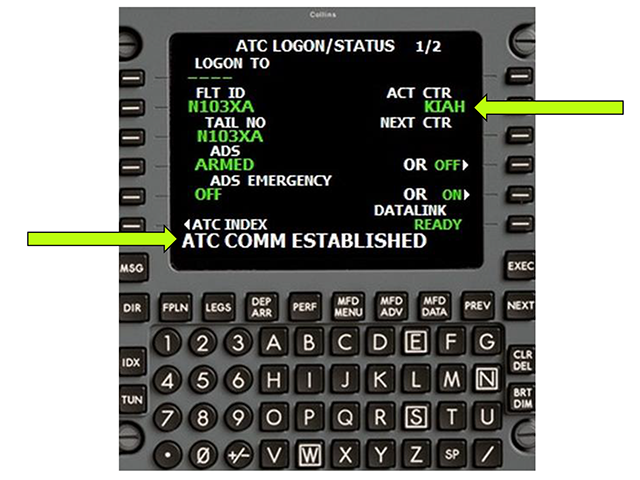
CPDLC Established, from Rockwell-Collins
Note: The LOGON should be to "KUSA" from all U.S. airports.
Crew Subsequent Actions Upon Receiving the DCL
- Review all pages
- "Accept" via CPDLC
- If the LOGON failed, revert to voice procedures
- ATC automatically terminates the data link connection between 5 - 10 minutes after takeoff.
- You will need to initiate a new LOGON to an en route ATSU, e.g. oceanic.
Source: Rockwell-Collins
6
Subscriber Database (SDB)
- The FAA's SDB contains records regarding Departure Clearance delivery preferences for all aircraft (DCL and PDC)
- ARINCDirect has administrative access.
- Using the correct entries in the SDB, the remark "DAT/1FANS2PDC" is no longer required to receive DCL.
Source: Rockwell-Collins
If you can have your SDB changed to reflect this preference, you don't need to add the flight plan remark.
If you use ARINCDirect for flight planning services, see the slide presentation from Rockwell-Collins, below, for instructions on how to edit your SDB entries.
It has been my experience that if you can indicate your preference in the SDB, you are better off. A trusted source in the FAA tells me:
The user can populate the SDB to identify which flights receive a FANS clearance or can create an entry in the DAT/ field. If they use both methods, the code in the DAT/ field takes precedence, i.e., if they insert DAT/1FANS in the flight plan, and the SDB entries are 1FANS 2PDC, and the aircraft departs from a PDC-only airport, the flight will NOT receive a PDC. An SDB entry is not necessary for the aircraft to receive the FANS clearance; however, if the pilot/dispatcher/provider wants to receive a Dispatch Copy (aka Courtesy Copy) of the clearance, then an SDB entry is required. Also, an SDB entry is required for the pilot to receive a PDC; inserting 1PDC into the DAT/ field does not guarantee the pilot will receive the PDC.
Source: Rockwell-Collins
7
Example
- Logged on to KTEB after the FMS was already programmed for the expected route.
- Received an ATC COMM ESTABLISHED message.
- The clearance arrived. Notice that the first page says "/CLEARED TO CMK" which is a VOR in New York. A few days later we were in KDAL flying to KBED and this page said "/CLEARED TO MEM" which was not our destination. In both cases this page simply meant that our clearance was different than our filed flight plan up until this particular point.
- After pressing the LSK for "ACCEPT" we must hit the LSK for "SEND".
- We are then prompted to review the flight plan.
- After reviewing we hit ACTIVATE and then CONFIRM REPLACING.
- The changed flight plan was entered into our FMS.
Note: The LOGON should be to "KUSA" from all U.S. airports.
References
(Source material)
CPDLC-DCL U.S. Airports Data Link Clearance Services, Rockwell-Collins, December 1, 2016
Departure Clearances Over Data Link, Honeywell Direct-To" October 2015
FANS Datalink Update, Honeywell Direct-To" February 2017




